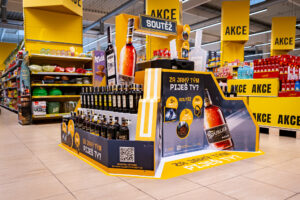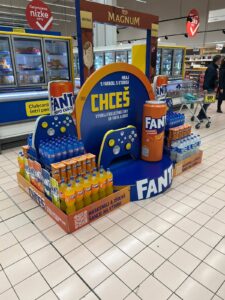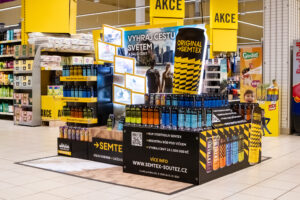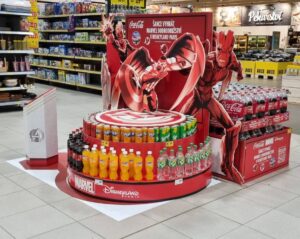Marvel heroes call for competition in Coca-Cola’s in-store campaign
The collaboration between two iconic brands like Coca-Cola and Marvel calls for something special.
Christmas Summary: How did Dago cope with Christmas POSs?
Before Christmas, traders always have to work hard to replenish the displayed goods. The shopping spree attracts consumers to visit permanent stores where they buy gifts for their loved ones. But how to stand out in crowded sales areas and reach the largest possible...
Celebrate Christmas with a unique Pilsner Urquell activation
Festive dress, potato salad, fried carp and something good to drink. This is what a classic Christmas Eve dinner looks like in many Czech households. Premium beer is an essential part of Christmas, just like Christmas sweets. This is also why the Pilsner Urquell brand...
You can’t miss the iconic Pringles chips on the new shelves
Pringles chips are known not only for their perfect hyperbolic paraboloid shape, but also for their irresistible taste.
Dago carried off two gold prizes from the POPAI Awards
On Thursday, November 24th, the festive announcement of the results of the POPAI Awards took place, just like every year.
Semtex’s shop-in-shop promotes the new Kofola campaign and impresses with its virtual reality
The energy drink brand Semtex comes together with the communication agency Dago with new shop-in-shops customers can see in selected Albert hypermarkets.
A new winter edition that will give you wings: Red Bull with apple and fig flavours
Red Bull is back with a new seasonal edition of its energy drinks.
Autumn in Albert stores: Pilsner Urquell once again bets on the history and tradition
The producer of the popular Czech beer – Plzeňský Prazdroj - has joined forces with the communication agency Dago. Their joint work resulted in displays in the form of the Jubilee Pilsen Gate and customers could see them in the sales areas of Albert supermarkets and...
We won gold at POPAI AWARDS PARIS
The prestigious European competition POPAI Awards Paris knows its winners. The winning projects, selected by an expert jury, were announced on September 15th in Paris.
A retail campaign from the company Mars draws attention to helping disadvantaged children
Orbit chewing gum brand from Mars has prepared a campaign called “Work & Study”, which, in conjunction with SOS Children’s Villages. The communication agency Dago helped it to enter the retail market.
Modern shopping – El Dorado of adventures and sci-fi helpers
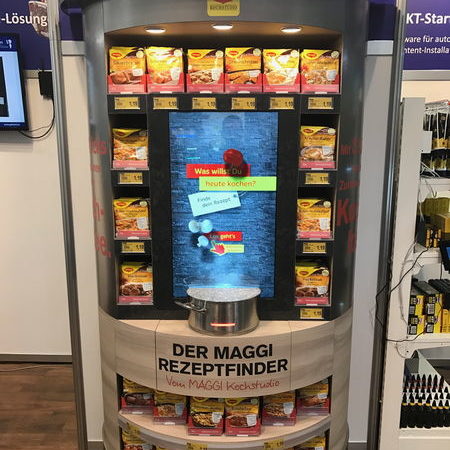
This year´s retail Trade Fair EuroShop showed that shopping is not just about getting goods anymore. Experiences customers are getting from a physical contact with a brand and products become the key role of shopping with more and more obvious ubiquity of modern technologies. An experiential shopping is today´s phenomenon associated with the generation change of the purchasing power. Surprising people and wow effects are becoming essential parts of a modern store as they can exceed customer´s expectations and fix an essence of brands in their hearts through analog and digital channels. Today´s stores, therefore, do not manage with simply exposing goods. Brands must try to make customers to enjoy spending their time nearby, offer them experiences, adventure, pamper them, expand their knowledge or refine their taste, offer them things they would not imagine themselves, thanks to which they enjoy something new or otherwise improve their lives.
In connection with the incredible selection on the Internet, which people have available all the time through their smartphones, stone stores must also change into a place of expert consultations. Shop assistants, as experts, will help with selection, expand the possibility of customer´s needs and become customer´s guide in their world of a relevant product inspiration. In this context, there is coming in a new phenomenon of curated shopping based on detecting and meaningfully satisfying existing and potential needs of customers. In connection with the incredible selection on the Internet, which people have available all the time through their smartphones, stone stores must also change into a place of expert consultations. Shop assistants, as experts, will help with selection, expand the possibility of customer´s needs and become customer´s guide in their world of a relevant product inspiration. In this context, there is coming in a new phenomenon of curated shopping based on detecting and meaningfully satisfying existing and potential needs of customers.

 SK
SK
